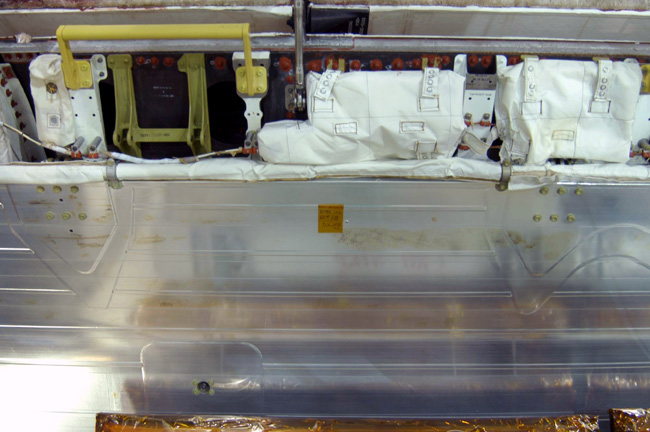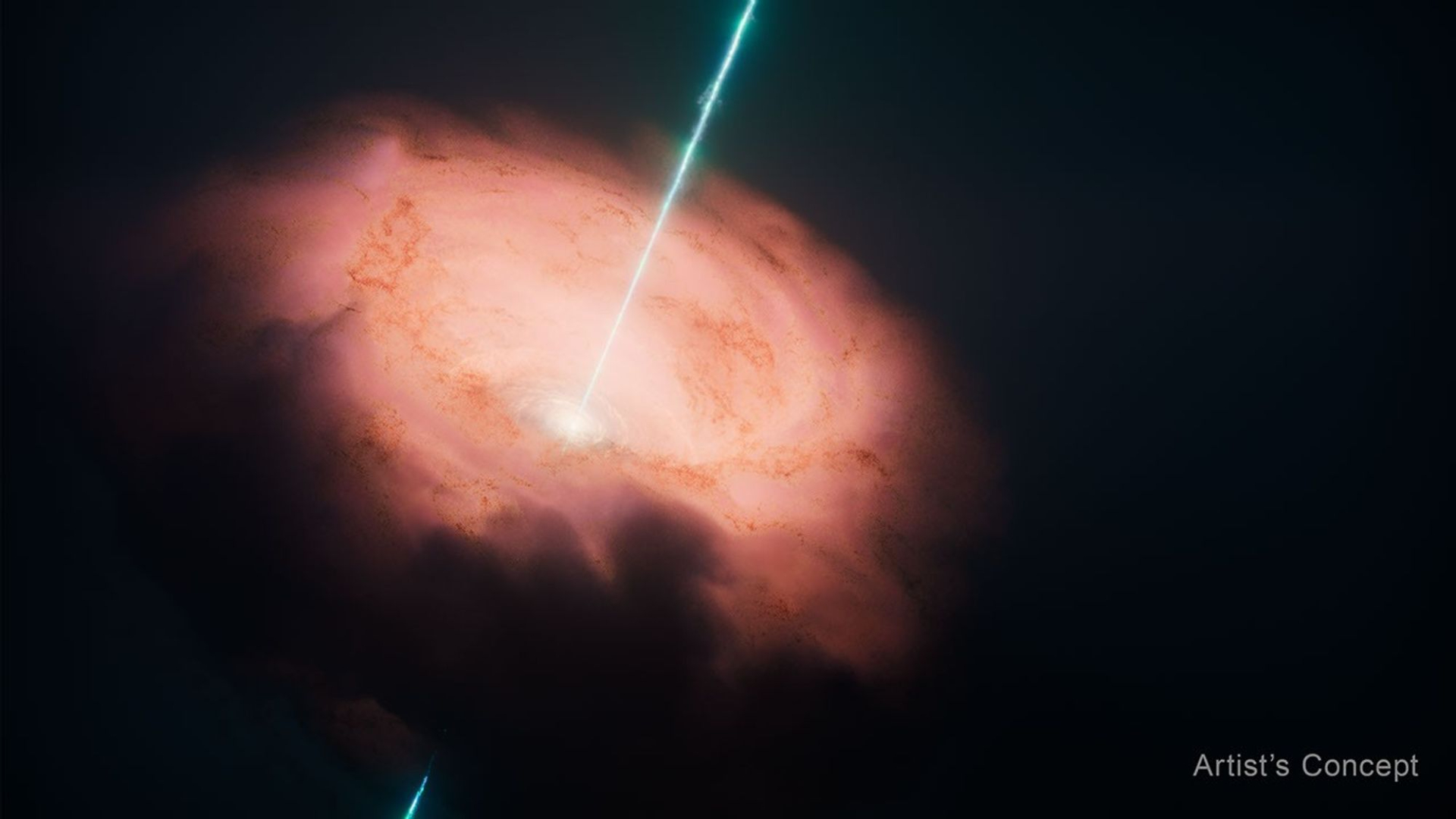NASA: Atlantis Shuttle's Radiator Struck by Object in September Flight

An unknown object pierced a radiator mounted to one of two cargo bay doors aboard NASA'sshuttle Atlantis during its Septemberspaceflight, but did not endanger the vehicle or its six-astronaut crew atany time, the space agency said Thursday.
"Althoughit's small, by comparison it may be the second largest impact we've been ableto detect on a payload bay door," NASA spokesperson Kyle Herring told SPACE.com."It did not do any other damage to the vehicle other than penetrate theradiator."
The impact occurredat some time during Atlantis' STS-115mission to install new trussesand solararrays at the InternationalSpace Station. The 13-day spaceflight ended with a predawnlanding on Sept. 21. Imagesof the damage site - dubbed"Ding 18" were first published by the website collectSPACE.com, and laterreleased by NASA.
Accordingto a schematicof the damage, the unknown object - either a micrometeoroid or other pieceof orbital debris - caused a small, one-tenth of an inch (2.5-millimeter) puncturein Atlantis' aft starboard radiator and appeared to leave a 0.031-inch (0.7-millimeter) exithole and a nearby crack.
"The natureof the object that hit the shuttle radiator isn't known," a NASA update said,adding that shuttle processing crews discovered the hole while working on thespacecraft.
The impactalso damaged a one-inch (2.5-centimeter) area in the radiator's honeycomb-likealuminum mesh, but did not sever any of the panel's 26 vital coolant tubes asit passed through the half-inch wide panel.
Atlantis's aftradiator panels each measure about 15.1 feet (4.6 meters) by 10.5 feet (3.2meters) and house 26 tubes for Freon-21 coolant.
Breaking space news, the latest updates on rocket launches, skywatching events and more!
Even if thebreach had severed one of the coolant tubes, Atlantis carries two redundant coolinglines, Herring said, adding that a Freon loop breach in one loop would have ledthe shuttle's onboard software to shut down the damaged system.
About 70percent of the orbiter's cooling needs could be met by one cooling loop, thoughthe situation would prompt discussions of whether to power down non-vitalelectronics or returning to Earth early depending on the mission's timeline, headded.
"It becomesa discussion and not an emergency situation," Herring said.
Atlantis'mystery objects
Atlantis'STS-115 astronauts - commanded by veteranshuttle flyer Brent Jett - conducted threein-depth scans of their spacecraft, though most of them were aimed atevaluating the health of the orbiter's heat shield and not its payload bay.
"This isexactly why we instituted the late inspection in this program," Herring said. "We'veknown for the life of this program that [micrometeorite and orbital debris] wasa top risk to the space shuttle. Definitely in the top five, and maybe in thetop three."
Just beforelanding, flight controllers and the astronauts themselves noted several items -later dubbed "mysteryobjects" - that appeared to have floated out of Atlantis' payload bay aftera series of thruster tests. The debris prompteda third and final round of heat shield inspection.
That scan alsoincluded a camera survey of Atlantis' payload bay to search for any missingobjects, and mission managers later gave the shuttle a cleanbill of health and clearedits crew for landing.
Mission managersdid not report any signs of the radiator impact after the payload bay survey. Theregion is not subjected to the severe heating stresses of atmospheric reentry,and would not have posed a threat to the orbiter during its Earth return, NASA officialshave said.
Watchingdebris
NASA haskept a close watch on launch and orbital debris since the loss of sevenastronauts and their spaceshuttle Columbia during reentry on Feb. 1,2003.
The vitalheat shield on Columbia's left wing leading edge - an area that sees some ofthe highest temperatures during reentry - was breached by a suitcase-sizedchunk of foam insulation from orbiter's external fuel tank 16 days earlier duringlaunch, and led to its destruction. NASA has since taken great strides toprevent foam insulation debris during launch, an effort that led to two,near-flawless launches this summer.
The damageseen on Atlantis' radiator - while not a threat to the spacecraft or its crew -is indicative of the potential impacts from micrometeoroids and orbital debris(MMOD) to spacecraft in flight. It is that hazard that prompted shuttle managersto addthe second heat shield inspection to July's STS-121mission and subsequent spaceflights.
"In simpleterms, there is a risk that you could be struck my MMOD," Atlantis' lead shuttleflight director Paul Dye said last month during the STS-115 mission, addingthat the risk is small but always present for any piloted spacecraft. "So wethink it's a prudent thing to take a look."
Meanwhile,NASA shuttle engineers continue to prepare Atlantis' sister ship Discovery forits STS-116mission to continue ISS construction. Commanded by experienced NASAastronaut MarkPolansky, the STS-116 will deliver a new piece of framework to the ISS,stage several spacewalks to rewire the station's power grid and ferrya new crewmember - first-timeflyer Sunita Williams - to join the outpost's Expedition14 crew.
Thespaceflight is slated to launch no earlier than Dec. 7 at 9:38 p.m. EST (0138Dec. 8 GMT) and mission managers discussed the mission's planned night launch,which would be the first since the Columbia accident, in a Thursday meeting.
"Theconsensus was that restoring night launch capability for the shuttle does notimpose any additional risk to the safety of the vehicle or the crew," Herringsaid. "Clearly launching in daylight is desirable, but everyone agreed it's notrequired."
- Complete Space Shuttle Mission Coverage
- Complete Coverage: ISS Expedition 14
- NASA's STS-115: Shuttle Atlantis to Jump Start ISS Construction
- The Great Space Quiz: Space Shuttle Countdown

Tariq is the award-winning Editor-in-Chief of Space.com and joined the team in 2001. He covers human spaceflight, as well as skywatching and entertainment. He became Space.com's Editor-in-Chief in 2019. Before joining Space.com, Tariq was a staff reporter for The Los Angeles Times covering education and city beats in La Habra, Fullerton and Huntington Beach. He's a recipient of the 2022 Harry Kolcum Award for excellence in space reporting and the 2025 Space Pioneer Award from the National Space Society. He is an Eagle Scout and Space Camp alum with journalism degrees from the USC and NYU. You can find Tariq at Space.com and as the co-host to the This Week In Space podcast on the TWiT network. To see his latest project, you can follow Tariq on Twitter @tariqjmalik.
